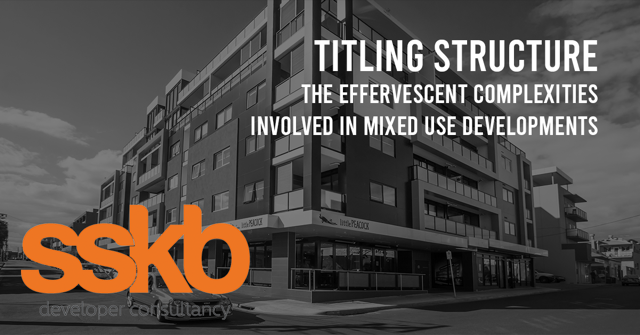When we discuss titling structure for a new development, particularly on a smaller scale, it is often as simple as a singular body corporate scheme in standard or building format plan. However, when a large site is acquired, it’s common that the site will be designed as a mixed-use precinct with a variety of components; retail, commercial, hotel, residential etc. This is where the complexities in titling begin. Dependent on what the mixed-use is comprised of, one of the following will likely be suggested by our consulting team.
Layered Bodies Corporate
A layered body corporate arrangement is the combination of more than one body corporate within a single development. This means that there is a principal scheme, and it is made up of lots and common property, and one of those lots is itself a body corporate. This is the subsidiary body corporate. It is possible to have several layers, not just one principal scheme with a number of subsidiaries. However, this is rare due to the complexity and additional layers of administration.
The concept of principal and subsidiary schemes is very useful when designing equitable arrangements for complex property developments. For instance, two high-rise towers (one with 40 floors and four lifts and the other with 5 floors and 2 lifts) may be built above four levels of shops and other retail facilities. All three may share a basement. If all three components share access ways and the basement for parking, then they would need to regulate their relationship through the use of a principal scheme. Since the shops are a different use, then they should be in a subsidiary body corporate. As the two high rise towers have different physical structures, it is appropriate that they are each in a separate body corporate. The following diagram illustrates this arrangement.

Building Management Statements (BMS)
A Building Management Statement (BMS) is a document that contains details on how two or more owners exist utilising common areas and utilities. It has similarities to a principal body corporate, but it is not a body corporate nor is it regulated by the same legislation.
A BMS is a registered document which is governed by the Land Title Act. It is an encumbrance that is registered on the title of each of the lots to which the statement applies. The document contains terms and conditions that benefit and burden the land to which the statement applies. It identifies all of the lots that are bound by its terms and conditions. There must be at least 2 lots bound by the statement. The lots must be 2 volumetric lots, or 1 standard format lot and 1 volumetric lot. The owners of the lots must sign the BMS agreeing to its terms before the statement can be registered. All of the lots to which the statement applies must be lots– :
- Wholly or partly contained in a building, or
- Wholly or partly containing a building.
The BMS may only have the content allowed under the legislation which creates it. It must have provisions that deal with the following necessities
- The supply of services to the lots
- The rights of owners, occupiers and invitees to access the lots. These rights are effective like easements and avoid the need for easements
- The rights of each of the lots to rely on the other lots for support and shelter
- The obligations of each of the parties to make appropriate insurance arrangements.
In addition to the mandatory provisions set out above, there are also the following optional matters that may be dealt with under the BMS
- The establishment and operation of a management group to make decisions relevant to the lots
- Financial matters, so that the lots have collected sufficient funds to spend on their joint responsibilities
- Maintenance of the lots and any shared areas
- Aesthetic matters that are controlled by an architectural or landscaping code
- Dispute resolution for the owners in respect of issues affecting the building and the BMS
- Arrangements for accomplishing extinguishments of the statement
The concept of a BMS can be very useful when designing a complex property development. For instance, two high-rise towers (one with 40 floors and four lifts and the other with 50 floors and 2 lifts) may be built above four levels of shops and other retail facilities. All three may share a basement. If all three components share access ways and the basement for parking, then they would need to regulate their relationship through the use of a BMS. Since the shops are very different to the towers and may be sold as freehold lots there is no need to include them in a body corporate. As the two high rise towers have different physical structures, it is appropriate that they are each in a separate body corporate. The following diagram illustrates this arrangement.

If you are undertaking a complex development in the future and wish to discuss how to best title your scheme, please do not hesitate to make contact on the below.
Oliver McCall
Development Consultant
0411 352 409
omccall@sskb.com.au
Michael Lovell
Development Consultant
0438 318 565
mlovell@sskb.com.au
Tim Sheehan
Director
0403 465 153
tsheehan@sskb.com.au
Bradley Jones
General Manager
0414655 284
bjones@sskb.com.au




Leave A Comment